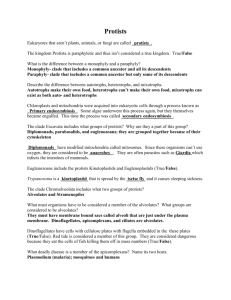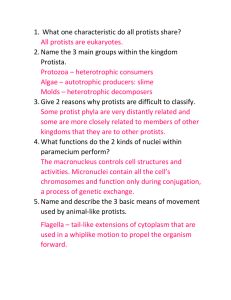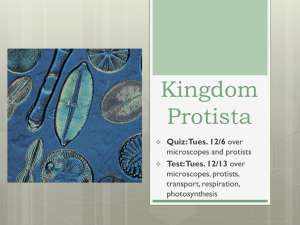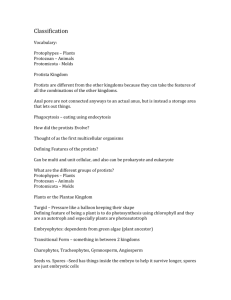Chapter 16: The Protists
advertisement
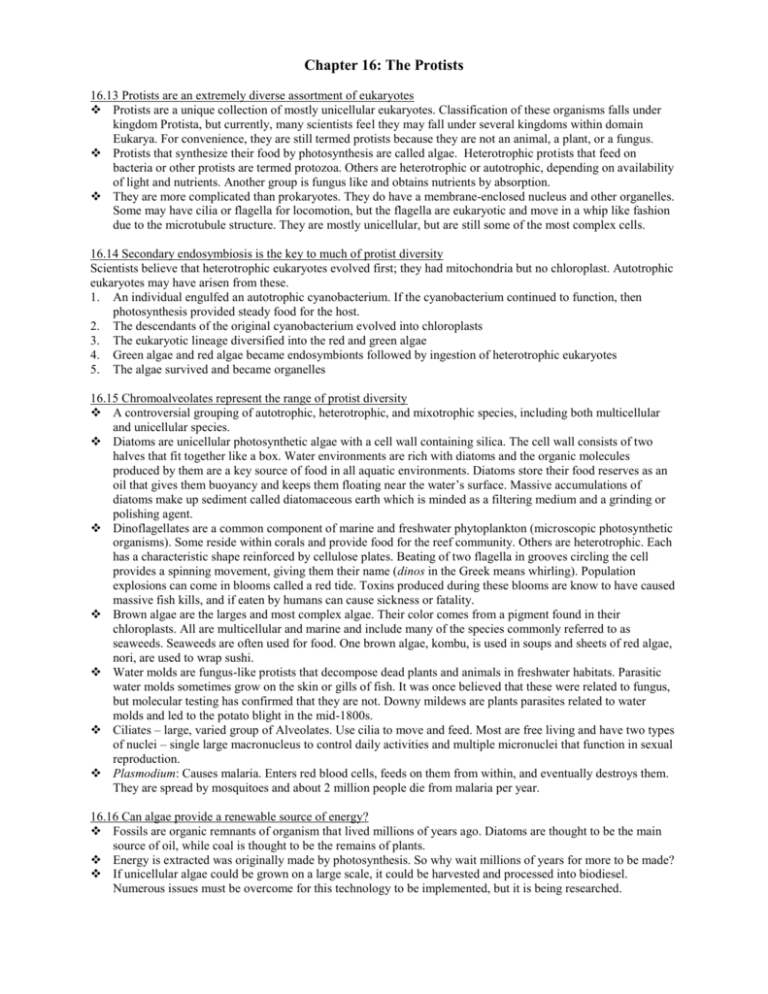
Chapter 16: The Protists 16.13 Protists are an extremely diverse assortment of eukaryotes Protists are a unique collection of mostly unicellular eukaryotes. Classification of these organisms falls under kingdom Protista, but currently, many scientists feel they may fall under several kingdoms within domain Eukarya. For convenience, they are still termed protists because they are not an animal, a plant, or a fungus. Protists that synthesize their food by photosynthesis are called algae. Heterotrophic protists that feed on bacteria or other protists are termed protozoa. Others are heterotrophic or autotrophic, depending on availability of light and nutrients. Another group is fungus like and obtains nutrients by absorption. They are more complicated than prokaryotes. They do have a membrane-enclosed nucleus and other organelles. Some may have cilia or flagella for locomotion, but the flagella are eukaryotic and move in a whip like fashion due to the microtubule structure. They are mostly unicellular, but are still some of the most complex cells. 16.14 Secondary endosymbiosis is the key to much of protist diversity Scientists believe that heterotrophic eukaryotes evolved first; they had mitochondria but no chloroplast. Autotrophic eukaryotes may have arisen from these. 1. An individual engulfed an autotrophic cyanobacterium. If the cyanobacterium continued to function, then photosynthesis provided steady food for the host. 2. The descendants of the original cyanobacterium evolved into chloroplasts 3. The eukaryotic lineage diversified into the red and green algae 4. Green algae and red algae became endosymbionts followed by ingestion of heterotrophic eukaryotes 5. The algae survived and became organelles 16.15 Chromoalveolates represent the range of protist diversity A controversial grouping of autotrophic, heterotrophic, and mixotrophic species, including both multicellular and unicellular species. Diatoms are unicellular photosynthetic algae with a cell wall containing silica. The cell wall consists of two halves that fit together like a box. Water environments are rich with diatoms and the organic molecules produced by them are a key source of food in all aquatic environments. Diatoms store their food reserves as an oil that gives them buoyancy and keeps them floating near the water’s surface. Massive accumulations of diatoms make up sediment called diatomaceous earth which is minded as a filtering medium and a grinding or polishing agent. Dinoflagellates are a common component of marine and freshwater phytoplankton (microscopic photosynthetic organisms). Some reside within corals and provide food for the reef community. Others are heterotrophic. Each has a characteristic shape reinforced by cellulose plates. Beating of two flagella in grooves circling the cell provides a spinning movement, giving them their name (dinos in the Greek means whirling). Population explosions can come in blooms called a red tide. Toxins produced during these blooms are know to have caused massive fish kills, and if eaten by humans can cause sickness or fatality. Brown algae are the larges and most complex algae. Their color comes from a pigment found in their chloroplasts. All are multicellular and marine and include many of the species commonly referred to as seaweeds. Seaweeds are often used for food. One brown algae, kombu, is used in soups and sheets of red algae, nori, are used to wrap sushi. Water molds are fungus-like protists that decompose dead plants and animals in freshwater habitats. Parasitic water molds sometimes grow on the skin or gills of fish. It was once believed that these were related to fungus, but molecular testing has confirmed that they are not. Downy mildews are plants parasites related to water molds and led to the potato blight in the mid-1800s. Ciliates – large, varied group of Alveolates. Use cilia to move and feed. Most are free living and have two types of nuclei – single large macronucleus to control daily activities and multiple micronuclei that function in sexual reproduction. Plasmodium: Causes malaria. Enters red blood cells, feeds on them from within, and eventually destroys them. They are spread by mosquitoes and about 2 million people die from malaria per year. 16.16 Can algae provide a renewable source of energy? Fossils are organic remnants of organism that lived millions of years ago. Diatoms are thought to be the main source of oil, while coal is thought to be the remains of plants. Energy is extracted was originally made by photosynthesis. So why wait millions of years for more to be made? If unicellular algae could be grown on a large scale, it could be harvested and processed into biodiesel. Numerous issues must be overcome for this technology to be implemented, but it is being researched. 16.17 Rhizarians include a variety of amoebas Rhizaria is a recently proposed clade, but some scientists believe it should be part of the chromoalveolata clade. Amoeba move by pseudopodia, which are temporary extensions of the cell. These are distinguished by a threadlike rather than lobe-like pseudopod. Foraminiferans are found in the ocean and freshwater. They have porous shells called tests, composed of organic materials and calcium carbonate. Pseudopods extend through the test. Most of those that have been identified are fossils. Radiolarians produce an internal skeleton of silica. Most of the radiolarians are marine. When they die, the hard parts settle to the bottom of the ocean and become part of the sediments. 16.18 Some excavates have modified mitochondria Excavata have recently been proposed as a clade. The name refers to an “excavated” feeding groove that some members of the group have. Euglena – common inhabitant of pond water. Characterized by one or more flagella extending from one end of the cell. Many species are photosynthetic but can also absorb nutrients as heterotrophs in the dark. Giardia intestinalis – a parasite that lives in the intestines of mammals. It is picked up by drinking water contaminated by the parasite. It leads to severe diarrhea, but can be prevented by boiling questionable drinking water. Trypanosoma – cells that are transmitted by the tsetse fly and take up residence in the blood stream. Infection leads to African sleeping sickness. 16.19 Unikonts include protists that are closely related to fungi and animals Unikonta is a controversial grouping that joins two other clades: amoebozoans and a second clade that includes animals and fungi. Amoeba are dispersed among many taxa and move by pseudopodia. Amoebozoans have lobe-shaped pseudopodia and the clade includes many species of free-living amoeba, parasitic amoeba, and some slime molds. Free-living amoeba creep over surfaces to move and may feed on other small protists. One parasitic amoeba causes amebic dysentery, which causes 100,000 deaths worldwide yearly. Plasmodia slime molds are common where there is moist, decaying organic matter. They are usually bright colors and have a branching body that is not multicellular. They contain many nuclei within the mass of cytoplasm, and the entire body is called a plasmodium. Many of the nuclei divide at the same time, so they are very useful in the study of mitosis. The plasmodium extends through a surface, engulfing food by phagocytosis as it spreads. Within channels of the plasmodium, cytoplasm streams through and helps to distribute nutrients. When nutrients are in short supply, the plasmodium stops growing and produces reproductive structures to release spores. These spores will release cells that fuse to form a zygote when conditions become favorable. Cellular slime molds are common on decaying organic matter. Most of the time they exist as solitary amoeboid cells, but when food is in short supply, these cells will collect together and form a slug-like aggregate that will wander around for a time. Some of those cells will dry up and form a stalk supporting reproductive structures and others will develop into spores for reproduction. 16.20 Archaeplastids include red algae, green algae, and land plants Almost all members of Archaeplastida are autotrophs. Red algae are found in warm coastal waters of the tropics. The red color comes from an accessory pigment that masks the green of the chlorophyll. They are typically soft-bodied but some have cells walls with har5d, chalky deposits. These encrusted species are found on coral reefs and are important parts in reef building. Green algae are named for the presence of chloroplasts. Chlamydomomas is common in freshwater lakes and ponds. It is propelled by two flagella (biflagellated) Volvox colonies are a hollow ball of biflagellated cells. Large colonies eventually release small daughter colonies from within them. Some are large enough to be considered seaweeds. Most green algae have a complex life cycle with alternation of generations, in which a multicellular diploid form alternates with a multicellular haploid form. The haploid forms are called gametophytes, and will produce gametes by mitosis. The diploid forms are called sporophytes. The fusion of the gametes begins the sporophyte generation. The sporophyte will then undergo meiosis to produce haploid, flagellated spores. These spores will sink to the bottom of the ocean and develop into a gametophyte. 16.21 Multicellularity evolved several times in eukaryotes Increased complexity makes variations possible. Multicellular organisms are fundamentally different from unicellular ones. They have specialized cells which perform different functions but depend on each other. This cooperation is evident in many cells today, such as colonial protists. Cells in multicellular organisms are specialized for many functions including feeding, waste removal, gas exchange, and protection.





